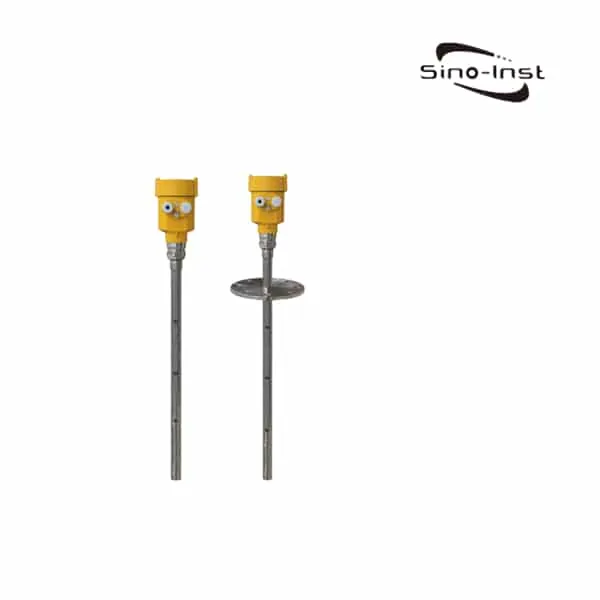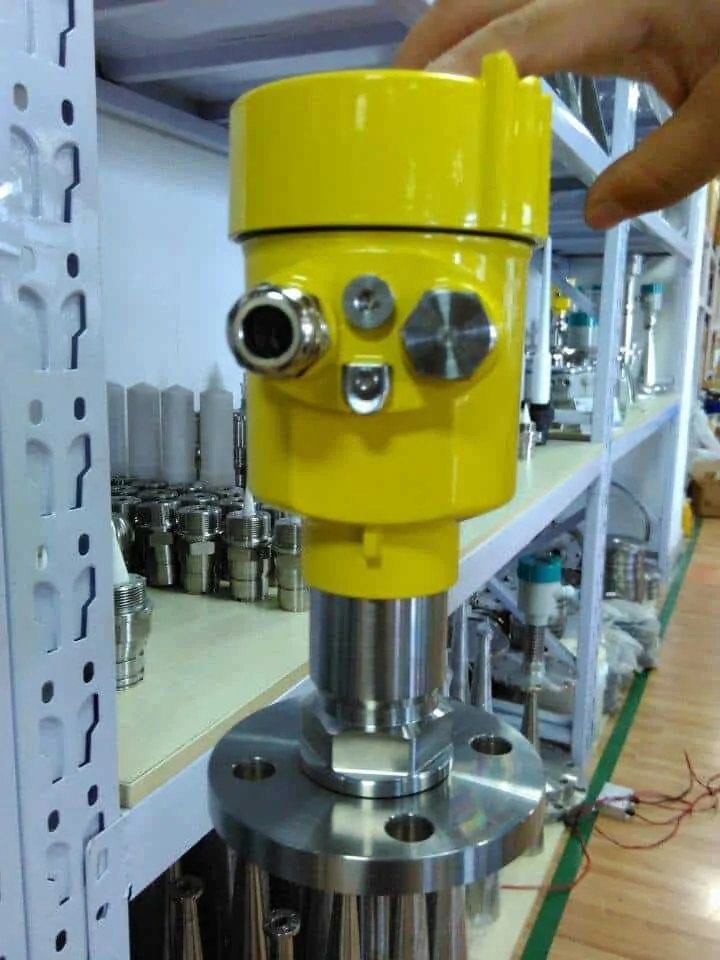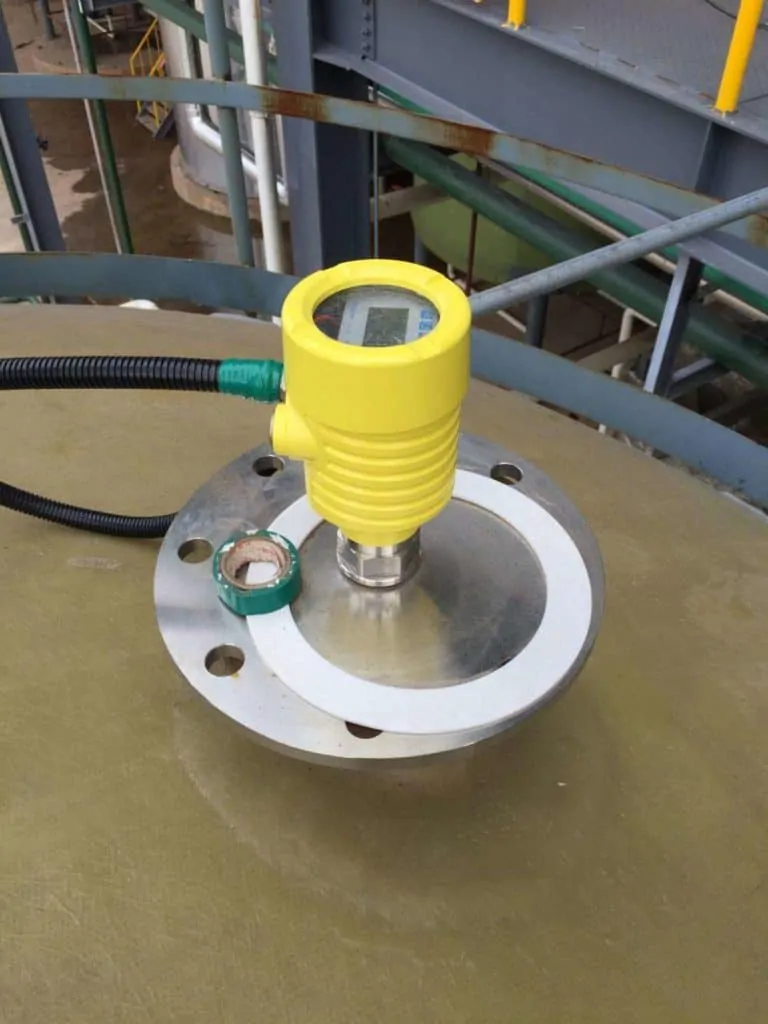Guided Wave Radar Level Transmitter with Coaxial tube type antenna is used to measure & control liquid with low permittivity. Contact measurement.

Guided wave radar level transmitters equipped with Coaxial Probe are used in liquids. Especially liquids with low dielectric constant. For example: non-ionized water, deoxygenated water and other liquid measurement. If the dielectric constant of the liquid is too low, radar level sensors are not suitable. Coaxial Probe Guided Wave Radar Level Transmitter can measure and control the level of liquids with low electrical constants or surface fluctuations. Signal output (4~20) mA/HART.
Sino-Inst offers a variety of Guided wave radar Level Sensors for industrial level measurement. If you have any questions, please contact our sales engineers.
Features of Coaxial Probe Guided Wave Radar Level Transmitter
- Applicable medium: liquid. Especially liquid with low dielectric constant. It can measure any medium with a dielectric constant greater than or equal to 1.4.
- Generally used to measure the medium with viscosity ≤ 500cst and not easy to produce adhesion.
- The maximum range of rod radar can reach 6 meters.
- It has a strong ability to inhibit steam and foam, and the measurement is not affected.
- For liquid materials with a relatively small dielectric constant. A double probe type measurement method can be used to ensure good and accurate measurement.
Find out about the Influence of Dielectric Constant on Guided Wave Radar Level Meter.
Specifications of Coaxial Probe Guided Wave Radar Level Transmitter
| Applicable medium: | Liquid, especially liquid with low dielectric constant |
| Should use: | Measurement of non-ionized water, deoxidized water, and other liquids |
| Explosion-proof certification: | Exia IIC T6 Ga/ Exd IIC T6 Gb |
| Measuring range: | 6m |
| Frequency rate: | 500MHz-1.8GHz |
| Day Line: | Coaxial tube antenna |
| measurement accuracy: | ±5mm |
| Process temperature: | -40~130℃(standard type)/-40~250℃(high-temperature type) |
| Process pressure: | (-0.1~4)MPa |
| Signal output: | (4~20)mA/HART |
| On-site display: | Four-digit LCD programmable |
| power supply: | Two-wire system (DC24V)/Four-wire system (DC24V/AC220V) |
| Outer shell: | aluminum single cavity/aluminum dual cavity/plastic/stainless steel single cavity |
| Process connection: | Thread/flange (optional) |
Extended Reading: Influence of Dielectric Constant on Liquid Level Measurement | Radar-Guided Wave Radar Level Meter
Advantages of Coaxial Probes
From an antenna perspective, there are roughly three types of guided wave radar level transmitters for tank level measurement. Rod-type, cable-type, and coaxial probe-type.
For rod-type and cable-type, please refer to the product page. Here, we will focus on the Coaxial Probe Guided Wave Radar Level Transmitter.
The antenna of the coaxial probe-type guided wave radar level transmitter mainly consists of two parts: a metal circular tube and a metal rod. To prevent the metal rod from touching the inner wall of the metal circular tube and causing interference. A fixing method must be used inside the tube.
In addition, circular holes are distributed on the metal circular tube. Which are used for the inflow of liquid medium in the tank.
The radar wave emitted by the coaxial probe-type guided wave radar level transmitter propagates in the space inside the metal circular tube. And the effective echo signal is stronger, resulting in more accurate measurement. Therefore, this measurement method is more suitable for measuring the level of liquids with low dielectric constants. Many deionized water and ion-free water level measurements will first consider this measurement method.
In addition, the special antenna structure of the coaxial probe-type guided wave radar level transmitter has strong anti-interference ability and is not easily affected by external factors. For certain special working conditions, this measurement method is more effective.
Furthermore, the coaxial probe-type guided wave radar level transmitter can complete measurements in small spaces and high temperature and pressure environments, making it more adaptable to different environments.
Finally, it has been documented that the coaxial probe-type guided wave radar level transmitter can be used to measure the height of different liquid interfaces. As different liquids have different dielectric constants. The radar wave emitted by the level transmitter encounters the interface and reflects back. Allowing for the theoretical possibility of measuring the position of different liquid interfaces.
In summary, from the above content, we can see that the coaxial probe-type guided wave radar level transmitter has a more concentrated energy, less interference. And more accurate measurement compared to other guided wave radar level transmitters.
Extended reading: GWR Solid Level Sensor-for Cement silo-Ash powder measure
Guided Wave Radar Level Transmitter Calibration Procedure
Here, we introduce the relatively common debugging methods and means of guided wave radar level transmitters. Users can determine the most appropriate method of use according to their actual situation. Finally proceed. Remember to be cautious when choosing a method, otherwise errors will easily occur.
More details about: Guided Wave Radar Level Transmitter Calibration
- Via HART handheld programmer. However, the HART handheld programmer has its adjustment range, which is not suitable for all products. The measurement range is 4-20mA corresponding value.
- Through the handheld adjustment module. Its function is equivalent to an analysis and processing instrument. The programmer is composed of buttons and a liquid crystal display. The adjustment menu and parameter settings can be displayed.
- Through the debugging software. Guided wave radar level gauge can be debugged through software. The process is: mainly use HART software for debugging, and an instrument driver is needed. Among them, when using software for debugging, power up the radar instrument with 24VDC. At the same time, add a 250 ohm resistor to the front end of the HART adapter. If the integrated HART resistance power supply meter, the internal resistance is 250 ohms. There is no need to add an external resistor. At this time, the HART adapter can be connected in parallel with the 4–20mA line.


Extended reading: Radar Level Meter for Corrosive Liquids
Frequently
Asked
Questions
Guided wave radar level transmitter price
The price of guided wave radar level transmitters can vary depending on several factors. Including the manufacturer, the model, the range, and the features of the device. Generally speaking, guided wave radar level transmitters are more expensive than other types of level measurement devices. Such as ultrasonic or capacitance level sensors, due to their advanced technology and accuracy.
Prices can range from a few hundred dollars to several thousand dollars per unit, depending on the specifications of the device.
In addition to the cost of the transmitter, there may be additional costs for installation, calibration, and maintenance.
While guided wave radar level transmitters can be a significant investment, they offer many benefits. Including improved accuracy, reliability, and versatility, which can make them a valuable asset in many industries.
Sino-Inst Guided wave radar level transmitter, made in China. Has a good product quality and price advantage. The price of our Guided wave radar level transmitter ranges from USD400-800.
The specific product price needs to be determined according to the actual product parameters. So, if you need a quotation for Guided wave radar level transmitter, please contact our sales engineer in time. Provide your measurement requirements, and you can get the price of Guided wave radar level transmitter within 24 hours.
More Level Measurement Solutions
Sino-Inst offers over 10 Guided Wave Radar level transmitters for level measurement. About 50% of these are Radar level meters, 40% is the tank level sensor.
A wide variety of Guided Wave radar level meters options are available to you, such as free samples, paid samples.
Sino-Inst is a globally recognized supplier and manufacturer of Guided Wave radar level measurement instrumentation, located in China.
Request a Quote

Wu Peng, born in 1980, is a highly respected and accomplished male engineer with extensive experience in the field of automation. With over 20 years of industry experience, Wu has made significant contributions to both academia and engineering projects.
Throughout his career, Wu Peng has participated in numerous national and international engineering projects. Some of his most notable projects include the development of an intelligent control system for oil refineries, the design of a cutting-edge distributed control system for petrochemical plants, and the optimization of control algorithms for natural gas pipelines.

